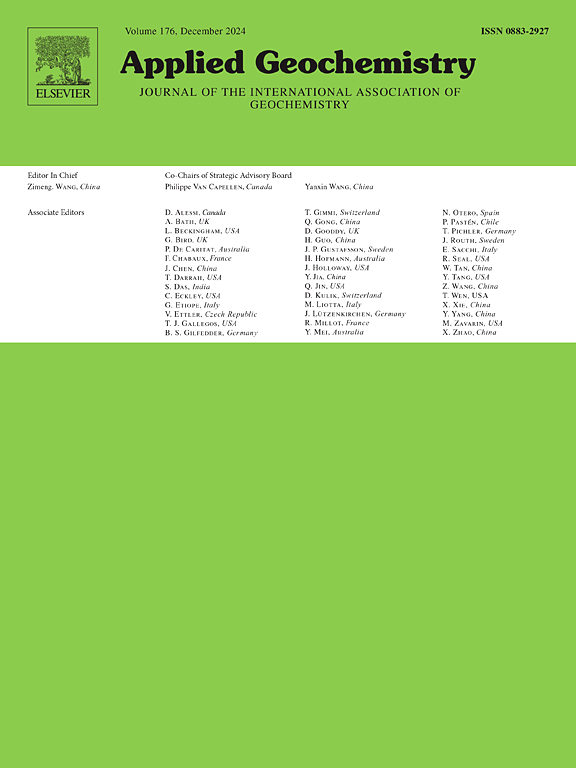用单粒子分析和透射电镜分析部分修复尾矿中铜的胶体迁移
IF 3.4
3区 地球科学
Q1 GEOCHEMISTRY & GEOPHYSICS
引用次数: 0
摘要
废弃矿山尾矿是全球范围内的环境和经济负担,通常需要进行大量的复垦工作。本研究结合单颗粒分析和透射电子显微镜,以及大量化学分析、超速离心和超滤技术,对加拿大马尼托巴省诺比明省立公园废弃金矿尾矿的化学、矿物学和胶体成分进行了解读。这些尾矿是富含黄铜矿的矿山废料排放的结果,近年来通过用富含白云石和有机质的土壤覆盖两个池塘进行了部分复垦。完全和部分受影响矿址的表层 pH 值、无机碳和有机碳含量均高于下层尾矿,而未受影响矿址的表层尾矿酸性更强,相对于更深处的还原区,铜含量更低。在提取的酸性浸出液中,Cu 的种类以 Cu2+ 和 CuSO4 为特征,而 Cu 有机复合物仅在从完全受影响地点和未受影响地点的还原层提取的弱酸性浸出液中发挥作用。对胶体部分的研究表明,许多胶体都有富含有机物或二氧化硅的包覆层,这些包覆层与 pH 值共同控制着胶体的 zeta 电位和聚集。随着胶体部分中铜浓度的增加,每个时间间隔内的颗粒数量和每个颗粒中铜浓度的相对标准偏差都会增加。相对于以铜为主要元素的胶体(含硫酸铜的胶体),含微量铜的胶体(如生物质胶体)和含少量铜的胶体(含粘土矿物的胶体)的比例增加较多,从而解释了这些相关性。对尾矿及其胶体部分的矿物学和化学成分进行比较后发现,在 pH 值为弱酸性的部分中和尾矿中以及在没有逸出盐的情况下,更有利于含铜胶体的形成。本文章由计算机程序翻译,如有差异,请以英文原文为准。
Deciphering colloidal transport of copper in partially remediated mine tailings by single particle analysis and transmission electron microscopy
Abandoned mine tailings are an environmental and financial liability worldwide and require often extensive reclamation efforts. A combination of single particle analysis and transmission electron microscopy, along with bulk chemical analysis, ultracentrifugation and ultrafiltration, are used to decipher the chemical, mineralogical and colloidal composition of an abandoned gold mine tailings at the Nopiming Provincial Park, Manitoba, Canada. The tailings are the result of the discharge of chalcopyrite-rich mine waste and were in recent years partially reclaimed through capping of two ponds with dolomite- and organic-rich soils. The surficial layers at the fully and partially affected sites have higher pH, inorganic and organic carbon content than the underlying tailings, whereas the surficial tailings at the unaffected site are more acidic and depleted in Cu relative to the reduced zone occurring at greater depth. The speciation of Cu in extracted acidic leachates is characterized by Cu2+ and CuSO4 species, whereas Cu-organic complexes only play a role in weak acidic leachates extracted from the fully affected site and the reduced layer at the unaffected site. Studies of the colloidal fraction indicate that many colloids are coated by organic- or silica-rich layers, which in combination with the pH control their zeta potential and aggregation. The number of particles per time interval and the relative standard deviation of the Cu concentration per particle increase at a higher rate with increasing concentration of Cu in the colloidal fraction. These correlations are explained with a greater increase in the proportions of colloids containing trace (e.g. biomass-based colloids) and minor (clay mineral-based colloids) amounts of Cu relative to colloids where Cu is a major element (Cu-sulfate bearing colloids). A comparison of the mineralogical and chemical composition of the tailings and their colloidal fractions indicates that the formation of Cu-bearing colloids is favored in partly neutralized tailings of weak acidic pH and in the absence of efflorescent salts.
求助全文
通过发布文献求助,成功后即可免费获取论文全文。
去求助
来源期刊

Applied Geochemistry
地学-地球化学与地球物理
CiteScore
6.10
自引率
8.80%
发文量
272
审稿时长
65 days
期刊介绍:
Applied Geochemistry is an international journal devoted to publication of original research papers, rapid research communications and selected review papers in geochemistry and urban geochemistry which have some practical application to an aspect of human endeavour, such as the preservation of the environment, health, waste disposal and the search for resources. Papers on applications of inorganic, organic and isotope geochemistry and geochemical processes are therefore welcome provided they meet the main criterion. Spatial and temporal monitoring case studies are only of interest to our international readership if they present new ideas of broad application.
Topics covered include: (1) Environmental geochemistry (including natural and anthropogenic aspects, and protection and remediation strategies); (2) Hydrogeochemistry (surface and groundwater); (3) Medical (urban) geochemistry; (4) The search for energy resources (in particular unconventional oil and gas or emerging metal resources); (5) Energy exploitation (in particular geothermal energy and CCS); (6) Upgrading of energy and mineral resources where there is a direct geochemical application; and (7) Waste disposal, including nuclear waste disposal.
 求助内容:
求助内容: 应助结果提醒方式:
应助结果提醒方式:


